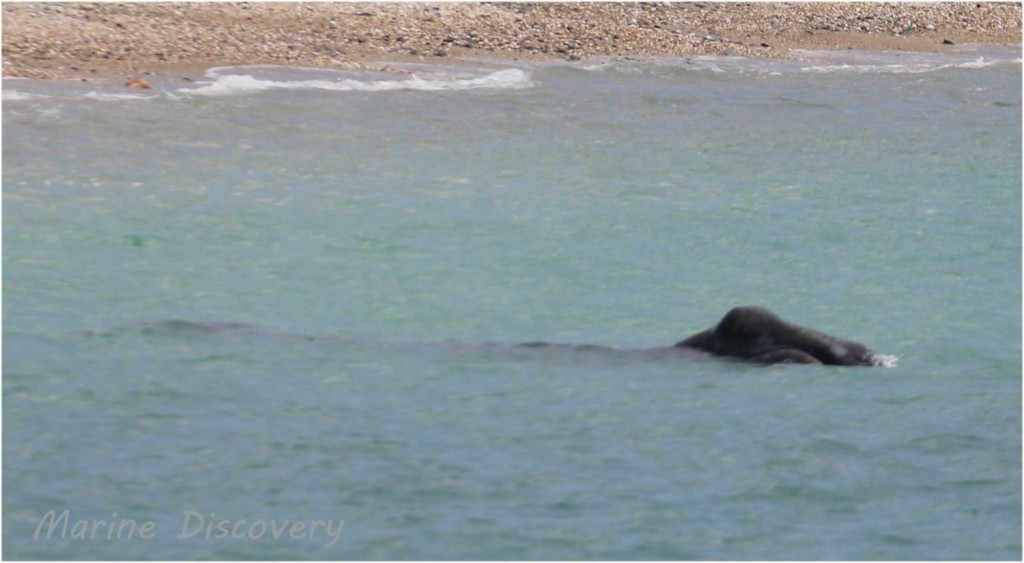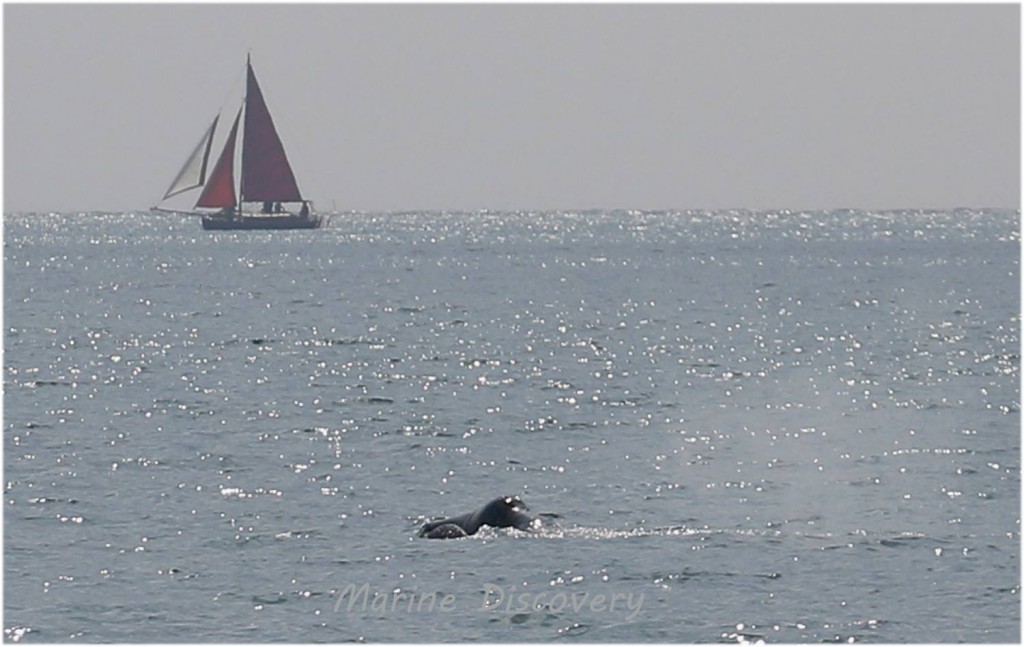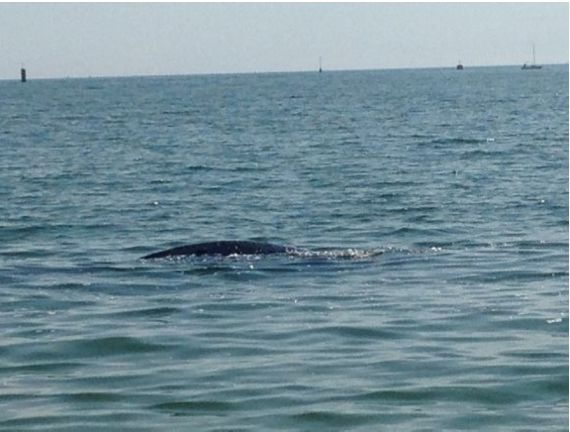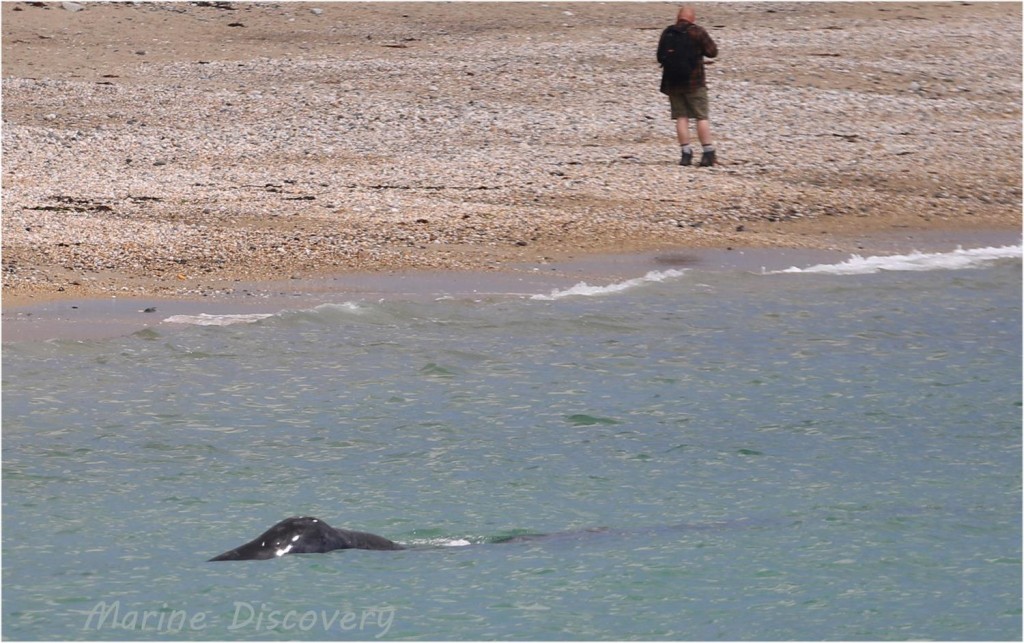Social media was buzzing yesterday when reports of Britain’s second ever bowhead whale sighting were broadcast over Facebook.
 Second bowhead whale ever to be seen in the UK photographed close to shore in Cornwall.
Photo: Marine Discovery/ Sea Watch Foundation
Second bowhead whale ever to be seen in the UK photographed close to shore in Cornwall.
Photo: Marine Discovery/ Sea Watch Foundation
The unidentified animal was seen close to shore at Marazion, near Penzance, in Cornwall, by regular marine mammal observer and medic, Dave Jarvis of BDMLR. Local boat operators, Marine Discovery Penzance, were on hand to go to sea and check out the report, and after initial thoughts that it might be a humpback whale, on-board whale researcher Marijke De Boer suspected that the animal was in fact a bowhead whale, making only its second appearance in UK waters in modern times.
Featuring a distinctive jaw-line and head shape, and lacking a dorsal fin, the bowhead whale looks rather different to the other 29 species of cetacean, which occur in UK waters. Nevertheless, it can be difficult to ascertain this with glimpsing views and distant photography.
 Here the animal’s distinctive jaw-line is clearly visible.
Photo: Marine Discovery/ Sea Watch Foundation
Here the animal’s distinctive jaw-line is clearly visible.
Photo: Marine Discovery/ Sea Watch Foundation
With excellent images having been widely circulated, Sea Watch Foundation were able to add to the confirmation that this Mount’s Bay animal was indeed a bowhead whale and a very significant sighting indeed! The first sighting of this species was just last year when a mystery whale was sighted off the Isles of Scilly. Back in February 2015, Sea Watch Foundation led a world-wide discussion into the identification of this particular visitor and were able to confirm with arctic whale experts that the first bowhead whale for the UK and in fact, elsewhere in Europe (south of the Barents Sea) had been recorded in Cornwall.
This time around, the photographic evidence is much clearer and such international collaboration was not needed to confirm the species. One clear diagnostic tool was a short video taken by Marine Discovery, which shows the double blow associated with the bowhead whale.
The first ever recorded sighting of a bowhead whale in the UK, off the Isles of Scilly in Feb 2015. Photo: Fay Page / Sea Watch FoundationThis new sighting may well be the same individual as was seen off St Martin’s on the Isles of Scilly last year. It is impossible to confirm, given the quality of the initial images. With close views, bowhead whales can be individually identified by looking at natural marks and callouses which build up over time.
Although it was very difficult to estimate size, observations and photographs of the first sighting (see photo above) suggested that it was a juvenile since the species can grow to a length of up to c. 65ft. This latest sighting also was thought to be a juvenile.
Just six days ago, a report of a mystery whale occurred at Bénodet off the coast of Brittany in North West France. Having now viewed the image to accompany the report, Sea Watch believes that this was also a bowhead whale, and likely the same animal that has now been seen near St Michael’s Mount in Cornwall. This being so, it would make the sighting in Cornwall yesterday the third for the species in Europe.
 This whale, seen off Britany, is thought to be the same animal seen off Cornwall yesterday.
Photo: The Télégramme (www.letelegramme.fr/finistere/benodet/benodet-un-cetace-devant-la-grande-plage-10-05-2016-11062660.php)
This whale, seen off Britany, is thought to be the same animal seen off Cornwall yesterday.
Photo: The Télégramme (www.letelegramme.fr/finistere/benodet/benodet-un-cetace-devant-la-grande-plage-10-05-2016-11062660.php)
 A bowhead whale; a second for the UK, in front of the iconic St Michael’s Mount.
Photo: Edward Hurst / Sea Watch Foundation
A bowhead whale; a second for the UK, in front of the iconic St Michael’s Mount.
Photo: Edward Hurst / Sea Watch Foundation
Bowheads normally live in the high arctic. Heavily exploited by whalers in the Arctic Ocean, in Baffin Bay off Greenland, and the Barents Sea north of Norway, the population seriously declined during the early twentieth century from numbers historically estimated to be around 30,000-50,000, reaching a low in the 1920s of c. 3,000. With the cessation of commercial whaling in the latter half of the last century, numbers globally have increased to somewhere between 15,000 and 20,000, mainly in the Beaufort Sea and Arctic Ocean. The Eastern Arctic-West Greenland population has increased recently and now is thought to number well over 3,500. There are no good estimates of abundance for the Spitsbergen and Okhotsk Sea stocks but they have shown no signs of significant recovery, and are considered highly endangered, probably numbering only a few hundred.
 Very close to an extremely rare whale!
Photo: Marine Discovery / Sea Watch Foundation
Very close to an extremely rare whale!
Photo: Marine Discovery / Sea Watch Foundation
Dr Peter Evans, Founder and Director of Sea Watch Foundation, the national marine charity which works to monitor whales, dolphins and porpoises in UK waters, says of the sighting “With global warming, one might wonder why this arctic species should be here. And the other week, another rare high arctic animal, the narwhal, turned up in the river Schelde, Belgium. One possible explanation is that ice melt is causing the ice to fragment, forming icebergs & pack ice to drift south from the arctic; both these species closely associate with ice. The welcome increase in the size of the West Greenland population may also be a contributory factor for why this creature appeared some two thousand miles from its normal range.”
Bowhead whale facts
Size: Length up to 18 metres (males) and 20 metres (females) and can weigh as much as 90 tonnes!
Head: Large (c. 40% of the body length) with a strongly arched mouth-line, and the eye placed just above the corner of the mouth. The baleen plates are the longest of any whale species – up to 14 ft long. The large head may be used to break through pack ice.
Body: Very rotund with a prominent bulge in the blowhole at the back of the head and a distinct depression behind that. There is no dorsal fin, but a slight dorsal hump in the middle of a smooth back. Coloration is generally dark, except for the tip of the lower jaw, which is pale (sometimes a pale area also around the tail, and occasionally on other parts of the body). Its blubber is the thickest of any whale.
Life Span: 100-200 years making this possibly the longest-lived of all marine mammals (evidence coming from old harpoon heads found in hunted individuals, and aspartic acid analysis from eye tissue). Bowheads reach sexual maturity at around 20 years of age.
Feeding: Small crustaceans (mainly copepods & krill) taken from near the surface by skim feeding.
Threats: Commercial whaling for bowhead whales started in the 1500s. However, as with several baleen whale species, most damage is thought to have occurred during the late nineteenth and early twentieth century, resulting in four of the five recognised stocks becoming highly endangered. The Bering-Chukchi-Beaufort (Western Arctic) stock is the only one with sizeable numbers (c. 10,000-13,000), increasing at c. 3% per annum, but, more recently, some of the other stocks have started to recover.
Other threats include noise disturbance from oil & gas exploration activities, entanglement in fishing gear, and pollution.

























